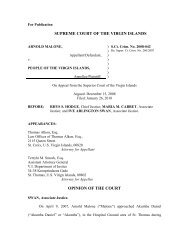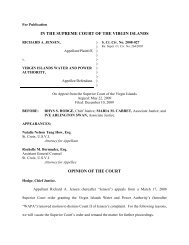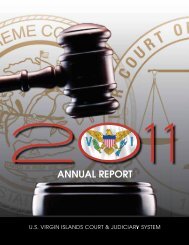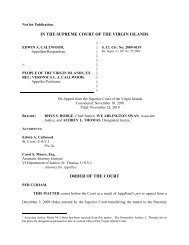IN THE SUPREME COURT OF THE VIRGIN ISLANDS OPINION OF ...
IN THE SUPREME COURT OF THE VIRGIN ISLANDS OPINION OF ...
IN THE SUPREME COURT OF THE VIRGIN ISLANDS OPINION OF ...
You also want an ePaper? Increase the reach of your titles
YUMPU automatically turns print PDFs into web optimized ePapers that Google loves.
For Publication.<strong>IN</strong> <strong>THE</strong> <strong>SUPREME</strong> <strong>COURT</strong> <strong>OF</strong> <strong>THE</strong> VIRG<strong>IN</strong> <strong>ISLANDS</strong>CRUCIANS <strong>IN</strong> FOCUS, <strong>IN</strong>C.,DEMMANSAY.COM, <strong>THE</strong> ECONOMICDEVELOPMENT AUTHORITY, <strong>THE</strong>ECONOMIC DEVELOPMENTCOMMISSION, <strong>THE</strong> GOVERNMENT <strong>OF</strong><strong>THE</strong> VIRG<strong>IN</strong> <strong>ISLANDS</strong>, ABC, <strong>IN</strong>C.,JOHN DOE 1, JOHN DOE 2, JANE DOE1, and JANE DOE 2,Appellants/Defendants,v.VI 4D, LLLP,Appellee/Plaintiff.))))))))))))))S. Ct. Civ. No. 2012-0093Re: Super. Ct. Civ. No. 376/2012 (STT)On Appeal from the Superior Court of the Virgin IslandsConsidered and Filed: October 15, 2012BEFORE:RHYS S. HODGE, Chief Justice; MARIA M. CABRET, Associate Justice; andIVE ARL<strong>IN</strong>GTON SWAN, Associate Justice.ATTORNEYS:Vincent A. Colianni II, Esq.Colianni Colianni & Alvis, LLCSt. Croix, U.S.V.I.Attorney for Appellant Crucians In Focus, Inc.Christopher A. Kroblin, Esq.Kellerhals Ferguson Fletcher Kroblin, LLPSt. Thomas, U.S.V.I.Attorney for AppelleePER CURIAM.OP<strong>IN</strong>ION <strong>OF</strong> <strong>THE</strong> <strong>COURT</strong>This matter is currently before the Court pursuant to the parties’ responses to this Court’sSeptember 27, 2012 Order, which required them to brief the issue of whether this Court shouldsummarily reverse or vacate several orders issued by the Superior Court in the underlying matter.
Crucians In Focus, Inc. et al v. VI 4D, LLLPS. Ct. Civ. No. 2012-0093Opinion of the CourtPage 2 of 11For the reasons that follow, we vacate all of the Superior Court’s temporary restraining orders(“TROs”) and reverse its decision to hold Crucians In Focus, Inc., in civil contempt.I. FACTUAL BACKGROUNDOn July 6, 2012, Crucians In Focus published a link to a copy of an application forbenefits from the Economic Development Commission (“EDC”) filed by VI 4D, LLLP, on itswebsite, cruciansinfocus.com. Crucians In Focus accompanied the link with commentary, titled“Your EDC Dollars At Work?”, which highlighted a portion of the EDC application thatidentified JaminDoodle Productions, LLC, as the sole general partner of VI 4D, and disclosedthat 49 percent of JaminDoodle is owned by the PBB Blind Trust, of which Pamela B.Berkowsky—the then-Chief of Staff of the Governor of the Virgin Islands—was the sole settlor.The EDC application also identified Adam M. Shapiro—whom the Crucians In Focuscommentary identified as Berkowsky’s husband—as one of the managers of VI 4D and the solemanager of JaminDoodle.On July 12, 2012, VI 4D filed an ex parte application for a TRO with the Superior Court,requesting, among other things, that Crucians In Focus be ordered to remove the link to the copyof its application for EDC benefits from its website, on the grounds that the application containedconfidential trade secrets and that the document was illegally released by an EDC employee.The Superior Court issued the TRO on July 13, 2012, and premised its decision solely on (1) itsapplication of the traditional four factor test 1 that governs requests for a TRO pursuant to Federal1 In its decision, the Superior Court, relying on SI Handling Sys., Inc. v. Heisley, 753 F.2d 1244, 1254 (3d Cir.1985), stated that VI 4D must establish (1) a reasonable likelihood of eventual success on the merits of its claims,(2) irreparable harm absent the TRO, (3) harm from the denial of the TRO that would outweigh any harm to thedefendants if relief is granted, and (4) that granting the relief would not adversely affect the public interest. See alsoWinter v. NRDC, 555 U.S. 7, 20 (2008); Munaf v. Geren, 553 U.S. 674, 689-90 (2008); Amoco Production Co. v.Gambell, 480 U.S. 531, 542 (1987); Weinberger v. Romero-Barcelo, 456 U.S. 305, 311-12 (1982).
Crucians In Focus, Inc. et al v. VI 4D, LLLPS. Ct. Civ. No. 2012-0093Opinion of the CourtPage 3 of 11Rule of Civil Procedure 65(b)(1)(A), see Super. Ct. R. 7, and (2) section 881(h) of title 3 of theVirgin Islands Code, which relates to injunctions restraining examination of specific publicrecords. 2After concluding that it would issue the TRO, the Superior Court stated that“[n]otwithstanding today’s ruling, the Court will require VI 4D to file a memorandum of lawfurther supporting its position that the issuance of this temporary restraining order does notrepresent a prior restraint under the first amendment.” Although the Superior Court orderedsupplemental briefing and recognized, in a single sentence in its analysis of the third Rule65(b)(1)(A) factor, that Crucians In Focus “may have [its] right to free speech abridged if thetemporary restraining order is granted,” the July 13, 2012 TRO contained no First Amendmentanalysis of any kind.While the Superior Court scheduled a preliminary injunction hearing for July 23, 2012,the matter was continued because Crucians In Focus failed to appear. On July 26, 2012, theSuperior Court held a show cause hearing on a motion by VI 4D to hold Crucians In Focus incontempt for failing to comply with the TRO. In an August 6, 2012 Opinion, the Superior Courtfound Crucians In Focus in civil contempt from July 19, 2012 through July 25, 2012, and fined it$1,000.00 for each day it violated the TRO. Although the Superior Court held a preliminaryinjunction hearing on the same day, it reserved decision, and to date has not issued a ruling.Likewise, the Superior Court has not ruled on an August 22, 2012 motion filed by Crucians In2 Since Crucians In Focus had already obtained a copy of VI 4D’s application, it is not clear how section 881(h) isapplicable to this matter, given that the provision relates to injunctions prohibiting the government from allowing amember of the public or the news media from viewing or copying a specific public record in the government’spossession. Additionally, it is not clear from the Superior Court’s decision whether the cruciansinfocus.com websiteitself contained the EDC application, or if it merely linked to a copy posted on demmansay.com—a potentiallysignificant distinction if Crucians In Focus and DemManSay are unrelated entities. See 47 U.S.C. § 230; Perfect 10,Inc. v. CCBill LLC, 488 F.3d 1102, 1118 (9th Cir. 1997) (holding 47 U.S.C. § 230 immunizes third parties fromliability for state law intellectual property claims). However, because Crucians In Focus has not raised any of theseissues, we decline to address, as part of this appeal, whether the Superior Court correctly applied these statutes to VI4D’s TRO application.
Crucians In Focus, Inc. et al v. VI 4D, LLLPS. Ct. Civ. No. 2012-0093Opinion of the CourtPage 4 of 11Focus, which requested that the Superior Court vacate the TRO as an impermissible priorrestraint in violation of the First Amendment, as well as dismiss VI 4D’s complaint for failure tostate a claim. Nevertheless, the Superior Court continued to issue orders extending the initial exparte TRO, none of which performed any First Amendment analysis.Crucians In Focus filed a notice of appeal on September 5, 2012, 3 which appealed fromthe August 6, 2012 Opinion holding it in civil contempt, as well as an August 17, 2012 Orderthat extended the TRO through September 3, 2012. This Court, in a September 12, 2012 Order,questioned its jurisdiction over the appeal since it appeared that the TRO had expired withoutrenewal. However, this Court subsequently discovered that the Superior Court extended theTRO in an order signed on September 4, 2012—but not entered onto the docket by the Clerk ofthe Superior Court until September 6, 2012—and then extended the TRO yet again in ordersentered on September 17, 2012 and September 25, 2012. Based on this information, this Courtconcluded that it likely possessed jurisdiction over this appeal, and issued a September 27, 2012Order requiring the parties to submit briefs addressing whether this Court should take summaryaction without full briefing by the parties because the appeal presents no substantial question.See V.I.S.CT. I.O.P. 9.4. In the days since briefing concluded, the Superior Court extended theex parte TRO two more times, in orders entered on October 10 and October 11, 2012.II. JURISDICTIONPrior to considering the merits of an appeal, this Court must first determine if it has3 Pursuant to Supreme Court Rule 4, “[a]n appeal permitted by law as of right from the Superior Court to theSupreme Court shall be taken by conventionally or electronically filing a notice of appeal with the Clerk of theSupreme Court in accordance with Rule 40, within the time allowed by Rule 5.” V.I.S.CT.R. 4(a). Since Appellantis represented by counsel, Supreme Court Rule 40.2(a)(1) required that the notice of appeal be electronically filedwith the Supreme Court. Crucians In Focus, however, conventionally filed its notice of appeal with the SuperiorCourt, and this Court only became aware of the appeal when its counsel ultimately filed the document with thisCourt on September 11, 2012.
Crucians In Focus, Inc. et al v. VI 4D, LLLPS. Ct. Civ. No. 2012-0093Opinion of the CourtPage 5 of 11appellate jurisdiction over the matter. V.I. Gov’t Hosps. & Health Facilities Corp. v. Gov’t, 50V.I. 276, 279 (V.I. 2008). “The Supreme Court shall have jurisdiction over all appeals arisingfrom final judgments, final decrees or final orders of the Superior Court, or as otherwiseprovided by law.” 4 V.I.C. § 32(a). “‘Section 32 embodies the final judgment rule, whichgenerally requires a party ‘to raise all claims of error in a single appeal following final judgmenton the merits.’” Bryant v. People, 53 V.I. 395, 400 (V.I. 2010) (quoting Enrietto v. RogersTownsend & Thomas PC, 49 V.I. 311, 315 (V.I. 2007)).While this Court has held that a non-party to the underlying litigation may immediatelyappeal a civil contempt order without waiting until entry of a final judgment, see In re Rogers,56 V.I. 325, 334 (V.I. 2012), it is well established that a party who is held in civil contempt maynot take an immediate appeal unless the civil contempt order was issued in connection withanother order that is immediately appealable, such as a preliminary injunction. See In reNajawicz, 52 V.I. 311, 326 (V.I. 2009). Thus, since Crucians In Focus is a defendant in theSuperior Court proceedings, this Court only possesses jurisdiction to review the civil contemptadjudication if it also has jurisdiction to review the TROs. In Najawicz, this Court explainedunder what circumstances a party may appeal a TRO:As a general rule, temporary restraining orders are not appealable interlocutoryorders. However, temporary restraining orders that are continued, without theconsent of the parties, for a substantial length of time past the period typicallypermitted by statute or court rule become, in effect, appealable preliminaryinjunctions. Here, although 14 V.I.C. § 606(h) states that a temporary restrainingorder shall expire within sixty days absent an extension for good cause, theSuperior Court has extended the August 5, 2008 TRO beyond the typical sixtyday period. Accordingly, the TRO has effectively become an appealablepreliminary injunction.Id. at 325 (quoting In re Miller, S. Ct. Civ. No. 2008-0080, 2008 WL 5605715, at *1 n.1 (V.I.Nov. 17, 2008) (unpublished)).
Crucians In Focus, Inc. et al v. VI 4D, LLLPS. Ct. Civ. No. 2012-0093Opinion of the CourtPage 6 of 11In this case, the Superior Court issued the original TRO pursuant to Federal Rule of CivilProcedure 65(b), which provides that a TRO obtained on an ex parte basis expires after 14 days.Fed. R. Civ. P. 65(b)(2). While VI 4D correctly notes that Rule 65(b)(2) authorizes a trial judgeto extend the TRO beyond the traditional 14 day period “for good cause,” our Najawicz decision,as well as the decisions of federal appellate courts interpreting Rule 65, unquestionably hold thata TRO that has been in place for three months without the consent of the parties is no longer“temporary,” but has transformed into an appealable preliminary injunction. See Najawicz, 52V.I. at 325; Sampson v. Murray, 415 U.S. 61, 86-88, n.58 (1974) (extended restraining order“must be treated as a preliminary injunction” and is appealable because it has “the same practicaleffect as the issuance of a preliminary injunction.”); SEC v. Black, 163 F.3d 188, 194 (3d Cir.1998) (extended restraining order “had effectively matured into a preliminary injunction”). Seealso Chicago United Indus., Ltd. v. City of Chicago, 445 F.3d 940, 943 (7th Cir. 2006) (treatingTRO as preliminary injunction because 20 days had elapsed since its issuance); In re Crawford,329 F.3d 131, 136 (2d Cir. 2003) (noting that TRO extended beyond the time limit of Rule 65(b)is treated as preliminary injunction); Nordin v. Nutri/Sys., Inc., 897 F.2d 339, 343 (8th Cir. 1990)(treating TRO as preliminary injunction because it exceeded Rule 65(b)’s time limit).Accordingly, this Court has jurisdiction to review the July 13, 2012 TRO and its subsequentextensions, and it also possesses jurisdiction over the August 6, 2012 Opinion holding CruciansIn Focus in civil contempt for violating the July 13, 2012 TRO. Najawicz, 52 V.I. at 326.III. DISCUSSIONIn our September 27, 2012 Order, this Court advised the parties that the instant appealmay qualify for summary disposition without full briefing and argument because the SuperiorCourt appeared to act contrary to binding precedent from the United States Supreme Court when
Crucians In Focus, Inc. et al v. VI 4D, LLLPS. Ct. Civ. No. 2012-0093Opinion of the CourtPage 7 of 11it granted the ex parte TRO. While prior restraints are not per se unconstitutional, the UnitedStates Supreme Court has not, in modern times, upheld a prior restraint on published speech, andin fact has held that a newspaper cannot be restrained from publishing, during wartime, topsecret government documents that were obtained illegally where the government fails to meet the“heavy burden of showing justification for the imposition of such a restraint.” See New YorkTimes Co. v. United States, 403 U.S. 713, 714 (1971). Moreover, the party that wishes to censorspeech bears the heavy burden of proving that the expression must be suppressed. See FW/PBS,Inc. v. City of Dallas, 493 U.S. 215, 225-27 (1990). Significantly, this Court noted that theSuperior Court itself recognized, in its initial July 13, 2012 Order, that VI 4D’s applicationimplicated the First Amendment and required further briefing, yet nevertheless issued an ex parteTRO and extended it for over three months without ever performing any First Amendmentanalysis.After reviewing the parties’ responses, we agree that the Superior Court committed afundamental error when it issued the ex parte TRO. While VI 4D argues that the prior restraintdoctrine does not prohibit a court from restraining, prior to final judgment, the dissemination oftrade secrets, the very authorities VI 4D relies upon support the fact that such restraining ordersand injunctions fall within the purview of the First Amendment. For instance, in DVD CopyControl Ass’n Inc. v. Bunner, 75 P.3d 1, 79-80 (Cal. 2003)—the main authority for VI 4D’sclaim that the prior restraint doctrine is inapplicable—the Supreme Court of California made thefollowing finding:[T]he narrow question before us is whether the preliminary injunction violatesBunner’s right to free speech under the United States and California Constitutionseven though DVD CCA is likely to prevail on its trade secret claim againstBunner. . . . In answering this question, we must first determine whetherrestrictions on the dissemination of computer codes . . . are subject to scrutiny
Crucians In Focus, Inc. et al v. VI 4D, LLLPS. Ct. Civ. No. 2012-0093Opinion of the CourtPage 8 of 11under the First Amendment. We conclude they are.The California Supreme Court then acknowledged that United States Supreme Court precedentprovides for different levels of scrutiny and, rather than applying a prior restraint analysis,applied the lower level of scrutiny set forth in Madsen v. Women’s Health Center, Inc., 512 U.S.753 (1994). In Madsen, the United States Supreme Court held that, even if a content-neutralinjunction does not constitute a prior restraint, a court must nevertheless apply a standardsomewhere between strict scrutiny and intermediate scrutiny:[W]hen evaluating a content-neutral injunction, we think that our standard time,place, and manner analysis is not sufficiently rigorous. We must ask insteadwhether the challenged provisions of the injunction burden no more speech thannecessary to serve a significant government interest.Id. at 765. In other words, even if the prior restraint doctrine is not implicated, an injunction thatrestricts speech must employ “the narrowest terms that will accomplish the pin-pointedobjective.” Id. at 767 (quoting Carroll v. President & Comm’rs of Town of Princess Anne, 393U.S. 175, 183 (1968)).We emphasize that a split in authority exists as to whether the prior restraint doctrineoutlined in New York Times Co. and its progeny, or the Madsen test, is applicable to the allegeddisclosure of trade secrets. As Crucians In Focus notes in its brief, the United States Court ofAppeals for the Sixth Circuit reached a result opposite to that adopted by the California SupremeCourt, holding that an order precluding a magazine from publishing documents, containing abusiness’s trade secrets that had been filed under seal in litigation but obtained from aconfidential source, constituted an impermissible prior restraint on speech. See Procter &Gamble Co. v. Bankers Trust Co., 78 F.3d 219, 224-25 (6th Cir. 1996). Additionally, the factthat Crucians In Focus accompanied the link to the EDC application with political commentary
Crucians In Focus, Inc. et al v. VI 4D, LLLPS. Ct. Civ. No. 2012-0093Opinion of the CourtPage 9 of 11could potentially render the instant situation sufficiently distinct from Bunner to warrant a higherlevel of scrutiny.Yet we do not need to resolve this question as part of this appeal, for the Superior Courtcommitted error regardless of which test applies. If Crucians In Focus is correct that the priorrestraint doctrine is applicable, the Superior Court should not have granted the TRO withoutperforming a prior restraint analysis. However, if VI 4D is correct that the prior restraintdoctrine is inapplicable, the Superior Court still erred by failing to apply the Madsen test. 4Andto the extent the Superior Court was uncertain as to which test should apply—which may verywell be the case since it ordered that VI 4D file a supplemental brief on the prior restraint issue,and has not issued a decision on the matter for more than three months—it should not haveissued the TRO while the First Amendment question remained unresolved, given that thefreedoms of speech and the press are fundamental rights and VI 4D bore the burden of provingthat the TRO did not infringe on Crucians In Focus’s First Amendment rights. In other words,under no circumstances should the Superior Court have altered the status quo by issuing an exparte TRO without performing any First Amendment analysis. Consequently, we vacate the July13, 2012 TRO, as well as all subsequent orders extending that TRO, and direct the SuperiorCourt to not issue a TRO or injunction until and unless it explicitly addresses the unresolvedFirst Amendment issues. 5Since we vacate the July 13, 2012 TRO, we likewise reverse the August 6, 2012 Opinion4 For example, if it believed the Madsen test applied rather than the prior restraint doctrine, the Superior Courtshould have considered in its July 13, 2012 Order whether a narrower form of preliminary relief would haveaccomplished the pin-pointed objective. The Superior Court, for instance, failed to explain why, rather thanrestraining Crucians In Focus’s ability to post any part of the EDC application, it could not simply require thatCrucians In Focus redact the specific parts of the EDC application that actually divulgated trade secrets.5 Given our decision to vacate the TRO and its subsequent extensions on this basis, we decline to address, as part ofthis appeal, Crucians In Focus’s claim that the Superior Court cannot issue a TRO when the sole claim in VI 4D’scomplaint is a request for a permanent injunction.
Crucians In Focus, Inc. et al v. VI 4D, LLLPS. Ct. Civ. No. 2012-0093Opinion of the CourtPage 10 of 11holding Crucians In Focus in civil contempt. See In re Drue, S. Ct. Civ. No. 2012-0051, 2012WL 4767278, at *6 (V.I. Oct. 5, 2012). While a party must ordinarily abide by an order, even ifhe or she believes it is contrary to law, numerous courts have held that a party should not be heldin contempt for violating an order that violates the First Amendment. See, e.g., Matter ofProvidence Journal Co., 820 F.2d 1342, 1353, modified on other grounds, 820 F.2d 1354 (1stCir. 1987) (holding publisher may not be held in contempt for violating transparentlyunconstitutional order restraining its speech); Phoenix Newspapers, Inc. v. Superior Court, 418P.2d 594, 596-97 (Ariz. 1966) (order infringing on First Amendment rights is void and cannot bethe basis for contempt penalty). As in Drue—which involved a failure to comply with an orderentered in violation of the Sixth Amendment—the July 13, 2012 TRO was not simply erroneous,but contrary to the United States Constitution and amendments thereto. 6 Therefore, since itwould be perverse to sustain the civil contempt sanction while simultaneously holding that theSuperior Court issued the July 13, 2012 TRO in violation of the First Amendment, we reversethe August 6, 2012 Opinion.IV. CONCLUSIONFor the foregoing reasons, this appeal presents no substantial question, since the SuperiorCourt violated binding precedent from the United States Supreme Court when it issued, andrepeatedly extended, the ex parte TRO without performing any First Amendment analysis.Accordingly, we vacate the July 13, 2012 TRO and all subsequent extensions, and reverse theAugust 6, 2012 Opinion holding Crucians In Focus in civil contempt.6 The First Amendment applies in the courts of the U.S. Virgin Islands to the same extent as it does in state andfederal courts through section 3 of the Revised Organic Act of 1954, the organizing document of this Territory.Gov't of the V.I. v. Brodhurst, 6 V.I. 509, 518 (D.V.I. 1968); People v. Brodhurst, 148 F.2d 636, 643 (3d Cir. 1945).The complete Revised Organic Act of 1954 is found at 48 U.S.C. §§ 1541-1645 (2006), reprinted in V.I. CODEANN., Historical Documents, Organic Acts, and U.S. Constitution at 73-177 (1995 & Supp. 2012) (preceding V.I.Code Ann. tit. 1).
Crucians In Focus, Inc. et al v. VI 4D, LLLPS. Ct. Civ. No. 2012-0093Opinion of the CourtPage 11 of 11ATTEST:VERONICA J. HANDY, ESQ.Clerk of the Court
















